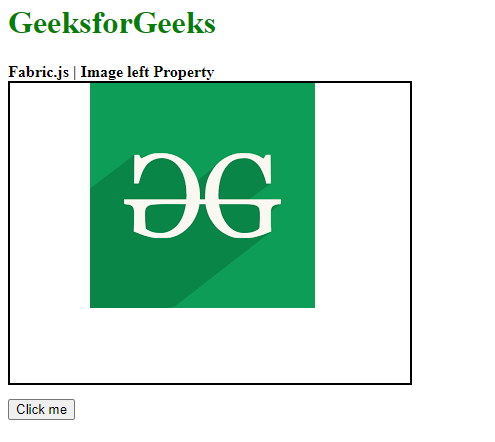Fabric.js Image left Property
Last Updated :
31 Aug, 2020
Fabric.js is a javascript library that is used to work with canvas. The canvas image is one of the class of fabric.js that is used to create image instances. The canvas image means the Image is movable and can be stretched according to requirement. The left property of the image is used to set the left position of the canvas image. By default, it is relative to the object left.
Approach: First import the fabric.js library. After importing the library, create a canvas block in the body tag which will contain the image. After this, initialize an instance of Canvas and image class provided by Fabric.JS and give the number to the left property as a parameter to set the left position of the image object.
Syntax:
fabric.Image(image, {
left:Number
});
Parameters: This function takes two parameters as mentioned above and described below:
- image: This parameter takes the image.
- left: This parameter takes a number to set the left position of the object.
Example:This example uses FabricJS to set the left position of the canvas image along the x-axis as shown in the below given example.
HTML
<!DOCTYPE html>
<html>
<head>
<script src=
</script>
</head>
<body>
<h1 style="color: green;">GeeksforGeeks</h1>
<b>Fabric.js | Image left Property </b>
<canvas id="canvas" width="400" height="300"
style="border:2px solid #000000">
</canvas>
<img src =
width="100" height="100" id="my-image"
style="display: none;"><br>
<button onclick="left()">Click me</button>
<script>
// Create the instance of canvas object
var canvas = new fabric.Canvas("canvas");
// Getting the image
var img= document.getElementById('my-image');
// Creating the image instance
var imgInstance = new fabric.Image(img, { left:75
});
function left(){
imgInstance = new fabric.Image(img, {
left:0
});
canvas.clear();
canvas.add(imgInstance);
}
// Rendering the image to canvas
canvas.add(imgInstance);
</script>
</body>
</html>
|
Output:
- Before clicking the button:

- After clicking the button:

Like Article
Suggest improvement
Share your thoughts in the comments
Please Login to comment...